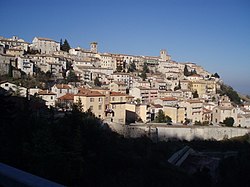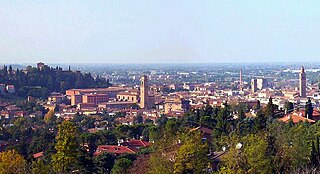
Cesena is a city and comune (municipality) in the Emilia-Romagna region of Italy, served by Autostrada A14, and located near the Apennine Mountains, about 15 kilometres from the Adriatic Sea. The total population is 97,137.

Fano is a town and comune of the province of Pesaro and Urbino in the Marche region of Italy. It is a beach resort 12 kilometres southeast of Pesaro, located where the Via Flaminia reaches the Adriatic Sea. It is the third city in the region by population after Ancona and Pesaro.

Sassoferrato is a town and comune of the province of Ancona in the Marche region of central-eastern Italy. It is one of I Borghi più belli d'Italia.

Senigallia is a comune and port town on Italy's Adriatic coast. It is situated in the province of Ancona in the Marche region and lies approximately 30 kilometers north-west of the provincial capital city Ancona. Senigallia's small port is located at the mouth of the river Misa. It is one of the endpoints of the Massa-Senigallia Line, one of the most important dividing lines (isoglosses) in the classification of the Romance languages.

Fermo is a town and comune of the Marche, Italy, in the Province of Fermo.
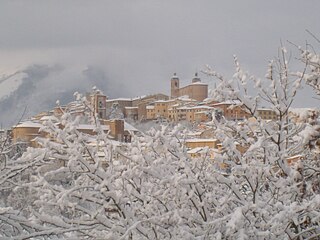
Camerino is a town in the province of Macerata, Marche, central-eastern Italy. It is located in the Apennines bordering Umbria, between the valleys of the rivers Potenza and Chienti, about 64 kilometres (40 mi) from Ancona.
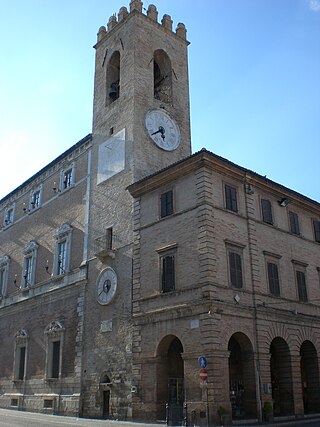
Osimo is a town and comune of the Marche region of Italy, in the province of Ancona. The municipality covers a hilly area located approximately 15 kilometres (9.3 mi) south of the port city of Ancona and the Adriatic Sea.

Tolentino is a town and comune of about 19,000 inhabitants, in the province of Macerata in the Marche region of central Italy.

Urbania is a comune (municipality) in the Province of Pesaro e Urbino in the Italian region of Marche, located about 80 kilometres (50 mi) west of Ancona and about 40 kilometres (25 mi) southwest of Pesaro, next to the river Metauro.

Barbara is a comune (municipality) in the Province of Ancona in the Italian region Marche, located about 40 kilometres (25 mi) west of Ancona. As of 31 December 2004, it had a population of 1,484 and an area of 10.8 square kilometres (4.2 sq mi).
Mergo is a comune (municipality) in the Province of Ancona in the Italian region Marche, located about 40 kilometres (25 mi) southwest of Ancona. As of 31 December 2004, it had a population of 1,063 and an area of 7.3 square kilometres (2.8 sq mi).
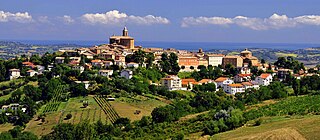
Montecarotto is a comune (municipality) in the Province of Ancona in the Italian region Marche, located about 40 kilometres (25 mi) west of Ancona, mostly known internationally for the annual Blackmoon festival, a renowned goa and psytrance happening. As of 31 December 2004, it had a population of 2,163 and an area of 24.1 square kilometres (9.3 sq mi).

Rosora is a comune (municipality) in the Province of Ancona in the Italian region Marche, located about 40 kilometres (25 mi) southwest of Ancona.
Serra de' Conti is a comune (municipality) in the Province of Ancona in the Italian region Marche, located about 40 kilometres (25 mi) west of Ancona.

Mogliano is a comune (municipality) in the Province of Macerata in the Italian region Marche, located about 50 kilometres (31 mi) south of Ancona and about 13 kilometres (8 mi) south of Macerata.
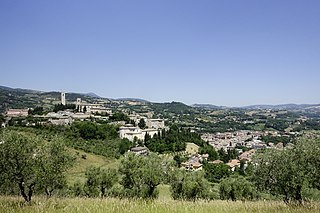
San Severino Marche is a comune (municipality) in the Province of Macerata in the Italian region Marche, located about 50 kilometres (31 mi) southwest of Ancona and about 25 kilometres (16 mi) southwest of Macerata.

Montalto delle Marche is a comune (municipality) and former Latin catholic bishopric in the Province of Ascoli Piceno in the Italian region Le Marche, located in the hilly area that goes from the Adriatic cost to the Sibillini Mountains, at a distance of about 70 kilometres (43 mi) south of Ancona and about 15 kilometres (9 mi) north of Ascoli Piceno, with a population of 1 991 inhabitants. The municipal territory covers a 34 km² area.

Offida is a comune (municipality) in the province of Ascoli Piceno, in the Italian region of Marche, located about 80 km south of Ancona and about 12 km northeast of Ascoli Piceno, on a rocky spur between the valleys of the Tesino and Tronto (south) rivers. It is one of I Borghi più belli d'Italia.

Stroncone is a comune (municipality) in the Province of Terni in the Italian region Umbria, located about 70 km southeast of Perugia and about 8 km south of Terni. It is one of I Borghi più belli d'Italia.

Sant'Andrea di Suasa is a hamlet of the municipality of Mondavio in the province of Pesaro-Urbino, Italy. The castle-village sits 265 metres above sea level, 23 km from the Adriatic coast and develops along the crest of a large hill to the left of the Cesano river. It is characterized by the mighty wall circuit still intact with a single arch entrance.
